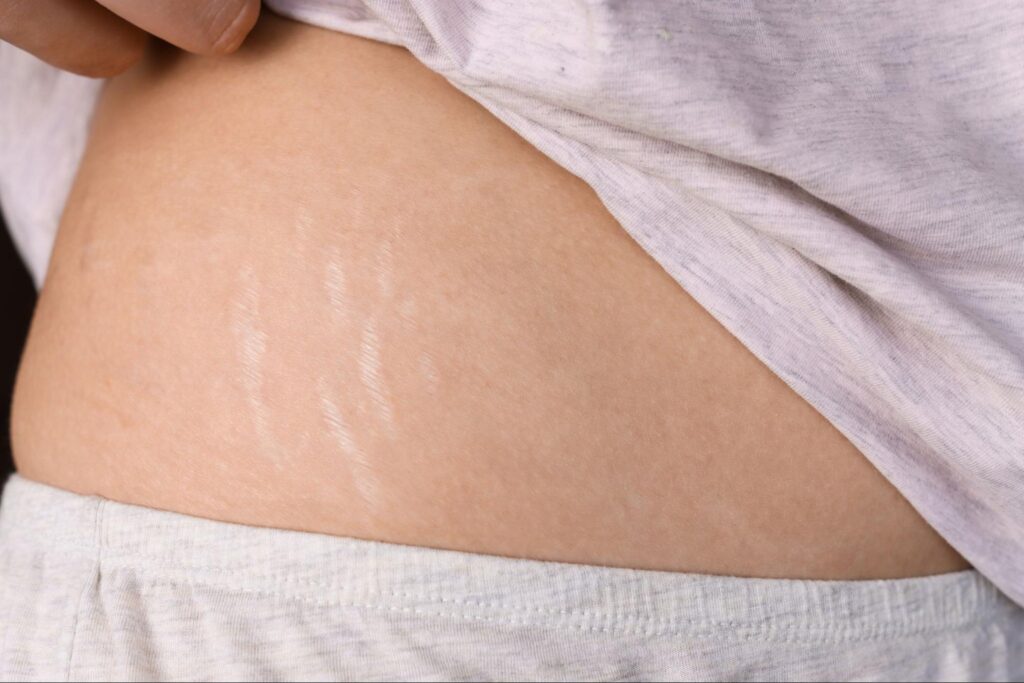Stretch marks are narrow, streak-like lines that develop on the skin when it stretches or shrinks too quickly, causing the collagen and elastin to rupture. Though harmless, it may affect confidence. They often appear during rapid physical change, such as weight gain, pregnancy, puberty, or intense muscle growth from bodybuilding. These marks vary in color and depth, often starting red or purple before fading to a lighter shade. Many seek permanent stretch mark removal to restore a more even skin tone and texture, especially when the marks become a reminder of bodily changes. While some accept stretch marks as natural, others prefer to explore treatments that offer smoother, clearer skin.
What Causes Stretch Marks?
Stretch marks form when the skin can’t keep up with sudden changes in body size. They typically appear as red, purple, or white streaks on the stomach, thighs, hips, or arms. Knowing what causes these marks helps you address them more effectively and prevent new ones from showing up:
Rapid Weight Gain
When the body gains weight quickly, the skin stretches too fast, leading to tearing in the middle layer. This disruption causes visible lines as the skin tries to heal and adapt. The marks often appear on the belly, thighs, and arms, where fat accumulates. Early signs usually look red or purple before fading.
Pregnancy
Hormonal changes and a growing belly during pregnancy put extra pressure on the skin. Stretch marks often appear on the stomach, breasts, hips, and lower back. They can form in the second or third trimester as the skin expands. Most women notice them after giving birth when the skin contracts again.
Puberty
Teenagers experience sudden growth spurts that make the skin stretch quickly. Boys often see marks on their shoulders and back, while girls get them on their hips and thighs. These changes happen fast, giving the skin little time to adjust. Marks developed during puberty can fade, but usually don’t disappear completely.
Bodybuilding
Muscle growth during intense training can stretch the skin too quickly, especially in the shoulders, arms, and chest. The skin tears slightly as it tries to accommodate larger muscles. Bodybuilders often deal with stretch marks even when their body fat is low. The marks may become more noticeable as the skin tightens around the muscles.
How to Remove Stretch Marks Permanently With Treatments
Many people search for ways to remove stretch marks completely, but not all treatments lead to permanent results. Some methods help fade the marks until barely visible, while others improve texture and tone over time. Results vary based on skin type, how old the marks are, and how consistently the treatment is used.
Laser Therapy
Laser treatments target the deeper layers of skin to boost collagen production and skin repair. Ablative lasers resurface the skin, while non-ablative options work beneath the surface without breaking it. Several sessions are usually needed to see strong results. Red or purple marks respond better than older white ones. This method helps make stretch marks less visible and improves skin texture.
Microneedling
Tiny needles create controlled injuries that trigger the skin’s healing process. Collagen and elastin production increase as the skin works to rebuild itself. Over time, treated areas become firmer and more even. Newer stretch marks respond faster, but older ones may need more sessions. Microneedling is often paired with serums to enhance its effect.
Chemical Peels
Acid-based solutions exfoliate the top layer of the skin to reveal newer skin underneath. The peeling process encourages cell turnover and helps fade discoloration. Deeper peels reach farther into the skin but require more recovery time. Light peels can be done more often for gradual improvements. Chemical peels soften the look of stretch marks and even out skin tone.
Microdermabrasion
A handheld device sands the skin’s surface and removes dead skin cells. Regular sessions help reduce the appearance of stretch marks and improve texture. This treatment works best on mild or shallow marks. It’s non-invasive and doesn’t need any recovery time. Microdermabrasion is often combined with topical products for better results.
Topical Retinoids
Prescription creams like tretinoin boost skin cell turnover and help rebuild collagen. These work best on fresh stretch marks that are still pink, red, or purple. Long-term use fades color and smooths out rough texture. Retinoids can irritate, so they should be used gradually. They are not safe for pregnant or breastfeeding women.
Radiofrequency and Ultrasound Therapy
These treatments use energy waves to heat the deeper layers of the skin and stimulate collagen production. The skin gradually tightens, which can reduce the depth and size of stretch marks. Ultrasound waves also help push active ingredients deeper into the skin. Multiple sessions are often needed for visible results. This method suits those looking for a non-invasive option with minimal downtime.

Progress Timeline of Medical Stretch Mark Removal
Stretch mark treatments take time, and results don’t show overnight. Each method has its own pace, depending on the skin’s condition and how early the marks are treated. Setting realistic expectations helps you stay consistent and avoid disappointment along the way.
First Few Weeks
As collagen activity begins, the skin may feel smoother and slightly firmer. Red or purple marks might begin fading to a lighter shade. Mild redness, peeling, or swelling can happen after treatments like microneedling or laser. It’s common for changes to be subtle at this stage. Sticking to post-treatment care helps maintain progress.
One to Three Months
Visible changes in texture and color become more noticeable. Stretch marks may flatten out slightly, and discoloration continues to fade. Most people need several sessions within this window to keep results moving. Skin tone begins to even out in treated areas. Regular appointments and skincare are still required for steady improvement.
Three to Six Months
Deeper marks respond more during this period, especially after repeat sessions. Treatments like radiofrequency or ultrasound start showing visible results in skin tightening. Marks become less raised and blend more into the surrounding skin. Collagen production remains active during this time. Patience pays off as long as treatments stay consistent.
Six Months to One Year
Most people see the most significant difference in this period. Older marks that were more stubborn begin to smooth out. Color, depth, and thickness continue to improve. Some may need maintenance treatments to maintain results long-term. Results depend heavily on skin type, treatment combo, and how early therapy started.
After One Year
Faded marks often settle into a softer, less visible form. Deep or white marks may remain slightly noticeable but far less intense. Maintenance sessions, once or twice a year, help preserve progress. The skin looks healthier and more even. While some results may plateau, most improvements stay permanent if the skin remains stable.
Topical Treatments for Removing Stretch Marks
Topical treatments are often the first option people try to fade stretch marks without invasive procedures. These products improve skin texture, boost collagen, and lighten discoloration. Consistent use over time helps support visible results, especially on newer marks.
Hyaluronic Acid
This ingredient hydrates the skin deeply and improves elasticity. Stretch marks may appear less noticeable as the skin plumps and softens. Results show up faster on newer marks. Many over-the-counter products include hyaluronic acid for this reason. Daily use can help maintain moisture and support the skin’s appearance.
Centella Asiatica and Peptides
Centella Asiatica is a herbal extract that soothes and supports healing, while peptides trigger collagen production. These ingredients help reduce redness and firm up the skin. Products containing them are often found in Korean or sensitive-skin formulas. Stretch marks look less defined after continued use. Combining these with other alternatives boosts the results.
Vitamin E and Cocoa Butter
Both are commonly found in drugstore stretch mark creams and oils. They improve skin softness and may reduce dryness, which makes marks more visible. These ingredients work better as prevention rather than a cure. Their ability to remove older stretch marks is limited. Still, they help keep skin smooth and moisturized.
Natural Oils
Rosehip, almond, and argan oils are popular for their fatty acids and antioxidant content. These oils improve skin tone and reduce inflammation around stretch marks. Results depend on how early and regularly they’re applied. Many like these alternatives because of their gentle feel and minimal side effects. They’re often used in combination with other treatments.

Remove Stretch Marks Permanently With Smart Solutions
Every stretch mark fades at its own pace, so sticking to what works for your skin makes a significant difference. Choosing the proper treatment mix helps improve the texture and appearance over time. Some options show faster results, while others need consistency before real changes. Acting early gives your skin a better chance of healing more evenly. Staying patient and focused keeps your progress on track without wasting time on things that don’t work.
Get real solutions on removing stretch marks permanently through helpful advice on the Pure Beauty Center of Fort Lauderdale blog.


